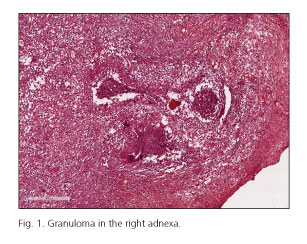My SciELO
Services on Demand
Journal
Article
Indicators
-
 Cited by SciELO
Cited by SciELO -
 Access statistics
Access statistics
Related links
-
 Cited by Google
Cited by Google -
 Similars in
SciELO
Similars in
SciELO -
 Similars in Google
Similars in Google
Share
Revista Española de Enfermedades Digestivas
Print version ISSN 1130-0108
Rev. esp. enferm. dig. vol.108 n.8 Madrid Aug. 2016
LETTERS TO THE EDITOR
Adnexal localization of Crohn's disease and recurrent massive ovary cysts
Key words: Crohn's disease. Gynecological manifestations. Ovary.
Dear Editor,
In a recent interesting case report, Saborit et al. (1) reported three cases of ovarian involvement in Crohn's disease (CD). In the first two cases, there were pelvic abscesses due to fistulae of ileal loops affected by CD, with involvement of the right ovary, which also showed abscesses and typical granulomas. In the third case there was an ovarian abscess, extension of the process by contiguity.
Granulomatous affectation of the ovaries is rare, with only 18 cases reported in the literature to date (2). Of this, in 17 cases the proposed mechanism of disease manifestation is direct fistulization between the small intestine and the ovary, which allows passage of vegetable material and results in the formation of reactive granulomas. In only one case (3) a patient that did not demonstrate the histological features of either fistula-related disease (an intact ovarian capsule was found) or idiopathic granulomatous disease caused by the multiplicity of the granulomas and the presence of central necrosis has been reported. The authors therefore suggested that their findings were consistent with a diagnosis of metastatic CD of the ovary.
Case report
We present the case of D. M., a 24-year-old nulliparous woman affected by ileocolonic CD. She underwent surgery due to a multiloculated collection in the pelvic cavity and in the right iliac fossa, with removal of the right ovary and of a massive pseudocyst. At the histological examination, a granulomatous flogosis with an adnexal localization of CD (lacking a fistula tract and vegetable foreign matter) (Fig. 1) and multiple inflammatory pseudocysts were observed at the right adnexa.
In the following years the patient underwent multiple ultrasound guided percutaneous drainage and surgical resection of massive cysts of the left ovary.
Discussion
This is the second reported case of adnexal localization of CD without fistula tract and vegetable foreign matter and the first with associated recurrent massive cysts of the contralateral ovary.
Davide Giuseppe Ribaldone1, Luca Conti2, Andrea Resegotti3 and Marco Astegiano1
1 Gastroenterologia University. Department of General and Specialized Medicine.
Città della Salute e della Scienza. Torino, Italy.
2 Department of Medical Sciences. University of Turin. Turin, Italy.
3 General Surgery. Department of General and Specialized Surgery.
Città della Salute e della Scienza. Torino, Italy
References
1. Saborit R, Roig A, García del Caño J, et al. Ovarian involvement in Crohn's disease: A rare complication. Rev Esp Enferm Dig 2016; 108:100-3. [ Links ]
2. Rindos N, Ecker A, Carter G, et al. Crohn's disease with ovarian granuloma: A case report and review of the literature. J Minim Invasive Gynecol 2015;22:914-6. DOI: 10.1016/j.jmig.2015.04.010. [ Links ]
3. Andreani SM, Dang HH, Edwards DP, et al. Ovarian Crohn's disease: Contiguous or metastatic? Inflamm Bowel Dis 2006;12:1091-2. [ Links ]














